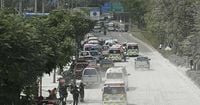On March 28, 2025, a powerful magnitude 7.7 earthquake struck central Burma, causing widespread panic and destruction. The earthquake occurred at 14:20 local time, approximately 16 kilometers northwest of the city of Sagaing. According to the U.S. Geological Survey (USGS), the tremor was felt not only across Burma but also in neighboring Thailand and as far as southeastern China.
Minutes after the initial quake, a magnitude 6.4 aftershock rattled the region, exacerbating fears among residents. In Naypyidaw, the capital of Burma, roads were severely deformed, and pieces of ceiling fell from buildings, causing injuries to many. Journalists on the scene reported that numerous victims were being treated at local hospitals, with one major hospital indicating that many casualties were expected.
In response to the disaster, the ruling Burmese junta declared a state of emergency across six regions, including Sagaing, Mandalay, Magway, northeast Shan State, Naypyidaw, and Bago, as they sought immediate humanitarian aid. The junta's spokesman, Zaw Min Tun, has urged citizens to donate blood for those injured in the aftermath, as hospitals in Mandalay, Naypyidaw, and Sagaing are overwhelmed with patients.
As the news spread, Indian Prime Minister Narendra Modi expressed his country’s readiness to provide assistance to both Burma and Thailand. This gesture of support highlights the regional solidarity in the face of such natural disasters.
In Thailand, the earthquake triggered panic in Bangkok, where a 30-story building under construction collapsed, trapping at least 81 workers inside. The Thai Vice Prime Minister, Phumtham Wechayachai, confirmed that at least three people had died as a result of the building's collapse, and rescue operations were underway to locate those still missing.
Thai Prime Minister Paetongtarn Shinawatra convened an emergency meeting in response to the disaster, declaring a state of emergency in Bangkok. Eyewitnesses described scenes of chaos, with many people evacuating offices and shops in fear. One resident recounted, "I heard the noise while I was sleeping at home, and I ran as far as I could in my pajamas." Another, aged 76, described his experience in a supermarket: "I rushed out of the store with other customers. It was the strongest shake I’ve ever felt in my life!"
In addition to the chaos in Thailand, reports from the Yunnan province in China indicated that residents felt tremors from the earthquake, with a recorded magnitude of 7.9 being reported by Chinese seismic agencies. This cross-border impact underscores the earthquake's severity and the interconnectedness of the region.
Historically, Burma is prone to seismic activity, with records showing six earthquakes of magnitude 7 or greater occurring between 1930 and 1956 near the Sagaing fault, which runs through the country. In 2016, a magnitude 6.8 earthquake struck Bagan, resulting in three fatalities and significant damage to historic temples. Another earthquake of similar magnitude in November 2012 killed 26 people and injured hundreds.
Experts have long warned that Burma’s weak infrastructure and inadequate healthcare services, particularly in rural areas, leave its population highly vulnerable to natural disasters. The current situation has raised concerns about the capacity of the military regime to respond effectively, given its isolation following the coup in February 2021.
As the situation unfolds, the international community is watching closely. The junta's appeal for humanitarian aid signals the potential extent of the damage and the urgent need for assistance. Images of the collapsed building in Bangkok and the destruction in Naypyidaw are stark reminders of the earthquake's devastation.
Reports from the National Museum of Burma in Naypyidaw indicated that the tremors caused significant damage there as well, with walls cracking and debris falling from the ceiling. Journalists present at the museum described the ground vibrating for a full thirty seconds, creating a terrifying experience for all inside.
As rescue efforts continue, the full extent of the casualties and damage remains to be seen. The situation is fluid, with updates expected as emergency services work to reach those trapped and provide care for the injured. The community's resilience will be tested in the coming days as they navigate the aftermath of this catastrophic event.
In light of the recent natural disasters, the importance of preparedness and robust infrastructure becomes ever more apparent. As Burma and Thailand grapple with the consequences of this earthquake, the focus will inevitably shift to recovery and rebuilding efforts, which will require both local and international support.







